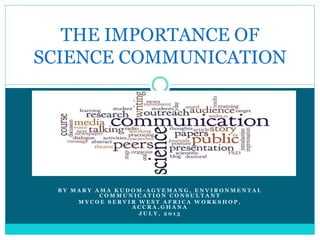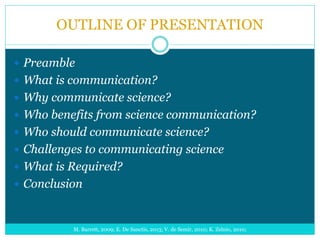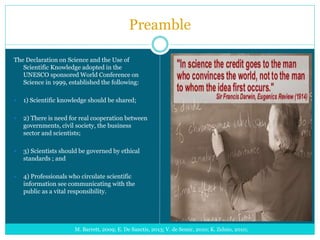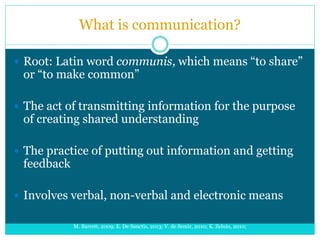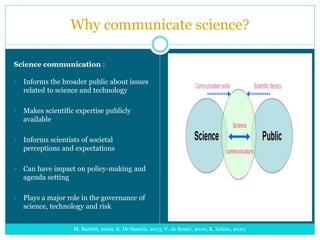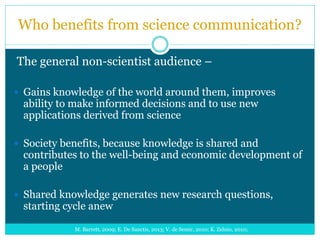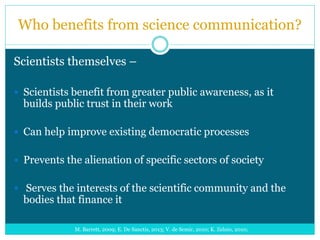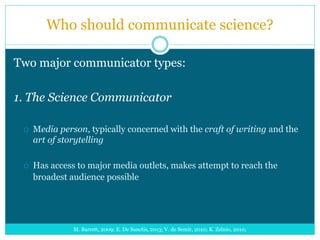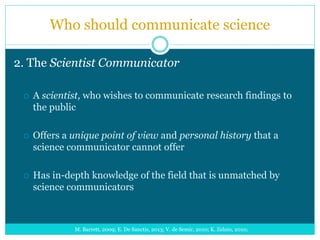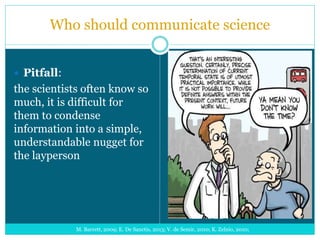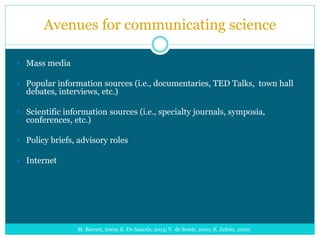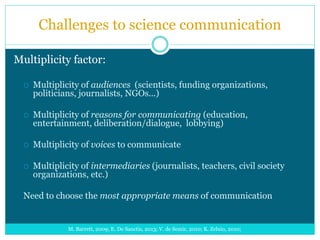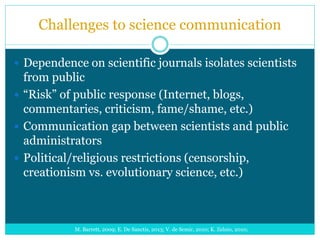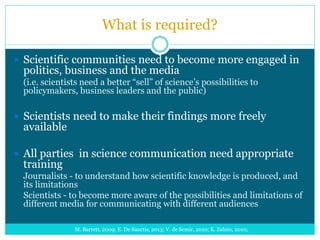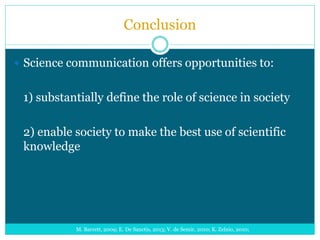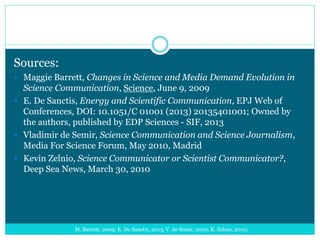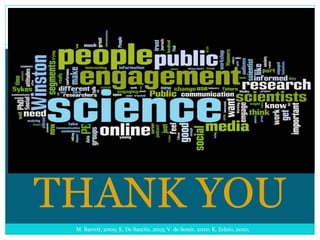THE IMPORTANCE OF SCIENCE COMMUNICATION.ppt
- 1. B Y M A R Y A M A K U D O M - A G Y E M A N G , E N V I R O N M E N T A L C O M M U N I C A T I O N C O N S U L T A N T M Y C O E S E R V I R W E S T A F R I C A W O R K S H O P , A C C R A , G H A N A J U L Y , 2 0 1 3 THE IMPORTANCE OF SCIENCE COMMUNICATION
- 2. OUTLINE OF PRESENTATION Preamble What is communication? Why communicate science? Who benefits from science communication? Who should communicate science? Challenges to communicating science What is Required? Conclusion M. Barrett, 2009; E. De Sanctis, 2013; V. de Semir, 2010; K. Zelnio, 2010;
- 3. Preamble The Declaration on Science and the Use of Scientific Knowledge adopted in the UNESCO sponsored World Conference on Science in 1999, established the following: 1) Scientific knowledge should be shared; 2) There is need for real cooperation between governments, civil society, the business sector and scientists; 3) Scientists should be governed by ethical standards ; and 4) Professionals who circulate scientific information see communicating with the public as a vital responsibility. M. Barrett, 2009; E. De Sanctis, 2013; V. de Semir, 2010; K. Zelnio, 2010;
- 4. What is communication? Root: Latin word communis, which means “to share” or “to make common” The act of transmitting information for the purpose of creating shared understanding The practice of putting out information and getting feedback Involves verbal, non-verbal and electronic means M. Barrett, 2009; E. De Sanctis, 2013; V. de Semir, 2010; K. Zelnio, 2010;
- 5. Why communicate science? Science communication : Informs the broader public about issues related to science and technology Makes scientific expertise publicly available Informs scientists of societal perceptions and expectations Can have impact on policy-making and agenda setting Plays a major role in the governance of science, technology and risk M. Barrett, 2009; E. De Sanctis, 2013; V. de Semir, 2010; K. Zelnio, 2010;
- 6. Who benefits from science communication? The general non-scientist audience – Gains knowledge of the world around them, improves ability to make informed decisions and to use new applications derived from science Society benefits, because knowledge is shared and contributes to the well-being and economic development of a people Shared knowledge generates new research questions, starting cycle anew M. Barrett, 2009; E. De Sanctis, 2013; V. de Semir, 2010; K. Zelnio, 2010;
- 7. Who benefits from science communication? Scientists themselves – Scientists benefit from greater public awareness, as it builds public trust in their work Can help improve existing democratic processes Prevents the alienation of specific sectors of society Serves the interests of the scientific community and the bodies that finance it M. Barrett, 2009; E. De Sanctis, 2013; V. de Semir, 2010; K. Zelnio, 2010;
- 8. Who should communicate science? Two major communicator types: 1. The Science Communicator Media person, typically concerned with the craft of writing and the art of storytelling Has access to major media outlets, makes attempt to reach the broadest audience possible M. Barrett, 2009; E. De Sanctis, 2013; V. de Semir, 2010; K. Zelnio, 2010;
- 9. Who should communicate science 2. The Scientist Communicator A scientist, who wishes to communicate research findings to the public Offers a unique point of view and personal history that a science communicator cannot offer Has in-depth knowledge of the field that is unmatched by science communicators M. Barrett, 2009; E. De Sanctis, 2013; V. de Semir, 2010; K. Zelnio, 2010;
- 10. Who should communicate science Pitfall: the scientists often know so much, it is difficult for them to condense information into a simple, understandable nugget for the layperson M. Barrett, 2009; E. De Sanctis, 2013; V. de Semir, 2010; K. Zelnio, 2010;
- 11. Who should communicate science? Science Communicator vs. Scientist Communicator: The science communicator = the translator someone with an excellent command of language, smart enough to understand the concepts and explain them to a lay audience, and able to ask the right questions of the scientist The scientists as communicator = first-hand originator of scientific information is important, because people want to hear about science from the scientists themselves M. Barrett, 2009; E. De Sanctis, 2013; V. de Semir, 2010; K. Zelnio, 2010;
- 12. Avenues for communicating science Mass media Popular information sources (i.e., documentaries, TED Talks, town hall debates, interviews, etc.) Scientific information sources (i.e., specialty journals, symposia, conferences, etc.) Policy briefs, advisory roles Internet M. Barrett, 2009; E. De Sanctis, 2013; V. de Semir, 2010; K. Zelnio, 2010;
- 13. Challenges to science communication M. Barrett, 2009; E. De Sanctis, 2013; V. de Semir, 2010; K. Zelnio, 2010; Multiplicity factor: Multiplicity of audiences (scientists, funding organizations, politicians, journalists, NGOs...) Multiplicity of reasons for communicating (education, entertainment, deliberation/dialogue, lobbying) Multiplicity of voices to communicate Multiplicity of intermediaries (journalists, teachers, civil society organizations, etc.) Need to choose the most appropriate means of communication
- 14. Challenges to science communication Dependence on scientific journals isolates scientists from public “Risk” of public response (Internet, blogs, commentaries, criticism, fame/shame, etc.) Communication gap between scientists and public administrators Political/religious restrictions (censorship, creationism vs. evolutionary science, etc.) M. Barrett, 2009; E. De Sanctis, 2013; V. de Semir, 2010; K. Zelnio, 2010;
- 15. What is required? Scientific communities need to become more engaged in politics, business and the media (i.e. scientists need a better “sell” of science’s possibilities to policymakers, business leaders and the public) Scientists need to make their findings more freely available All parties in science communication need appropriate training Journalists - to understand how scientific knowledge is produced, and its limitations Scientists - to become more aware of the possibilities and limitations of different media for communicating with different audiences M. Barrett, 2009; E. De Sanctis, 2013; V. de Semir, 2010; K. Zelnio, 2010;
- 16. Conclusion Science communication offers opportunities to: 1) substantially define the role of science in society 2) enable society to make the best use of scientific knowledge M. Barrett, 2009; E. De Sanctis, 2013; V. de Semir, 2010; K. Zelnio, 2010;
- 17. Sources: Maggie Barrett, Changes in Science and Media Demand Evolution in Science Communication, Science, June 9, 2009 E. De Sanctis, Energy and Scientific Communication, EPJ Web of Conferences, DOI: 10.1051/C 01001 (2013) 20135401001; Owned by the authors, published by EDP Sciences - SIF, 2013 Vladimir de Semir, Science Communication and Science Journalism, Media For Science Forum, May 2010, Madrid Kevin Zelnio, Science Communicator or Scientist Communicator?, Deep Sea News, March 30, 2010 M. Barrett, 2009; E. De Sanctis, 2013; V. de Semir, 2010; K. Zelnio, 2010;
- 18. THANK YOU M. Barrett, 2009; E. De Sanctis, 2013; V. de Semir, 2010; K. Zelnio, 2010;
